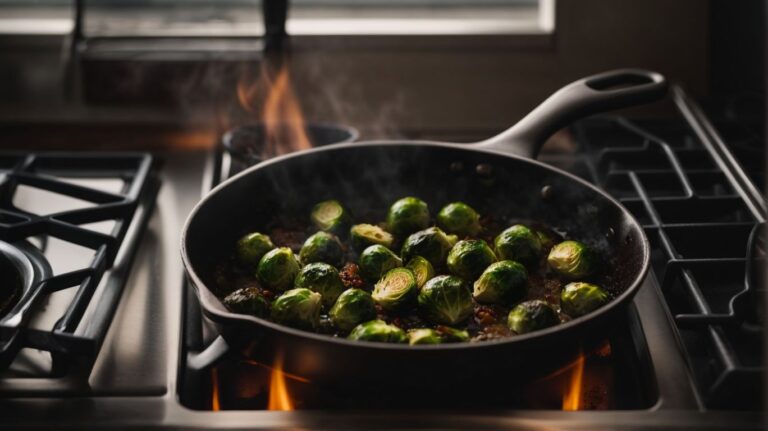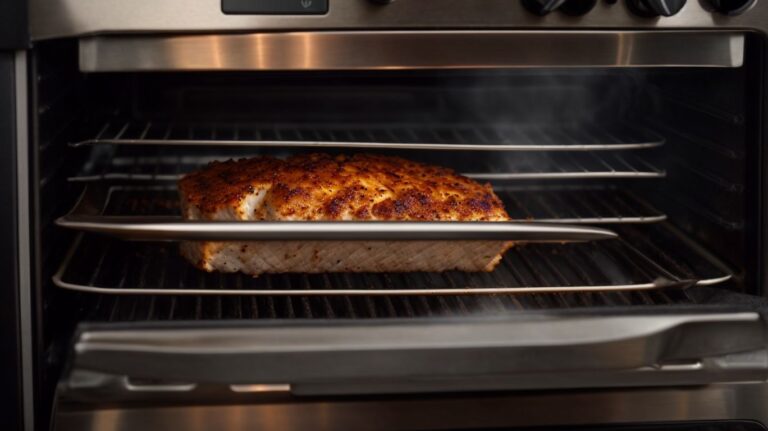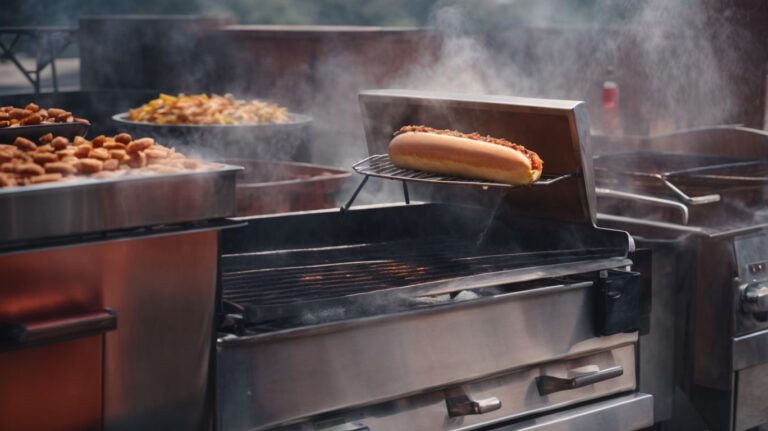How to Cook Bacon on Microwave?
Looking for a quick, easy, and mess-free way to cook bacon?
Explore the benefits of cooking bacon in the microwave, including how it is a healthier option and requires less clean-up. Find out important factors to consider and a step-by-step guide for perfectly cooked bacon every time.
Get tips, tricks, and learn common mistakes to avoid when cooking bacon in the microwave. Let’s get cooking!
Key Takeaways:
Why Cook Bacon on Microwave?
Cooking bacon in the microwave offers a quick and easy method to achieve crispy, delicious results with minimal effort.
One of the key benefits of preparing bacon in the microwave is the convenience it offers—no need to deal with splattering grease or a messy stovetop cleanup. By using a microwave-safe dish or a specially designed bacon cooker, you can efficiently cook individual slices or a whole batch at once.
The microwave method significantly reduces the cooking time compared to traditional stovetop methods, allowing you to enjoy your favorite crispy bacon in just a few minutes. This approach also results in a consistent and evenly cooked texture, with the added advantage of controlled cooking to achieve your preferred level of crispiness.
Quick and Easy
Cooking bacon in the microwave is a quick and easy process that takes just a few minutes to achieve perfectly cooked bacon slices.
One of the main advantages of cooking bacon in the microwave is the time-saving aspect of this method. Unlike traditional stovetop cooking, which requires constant monitoring and flipping, the microwave allows you to set the cooking time and walk away, freeing you up to attend to other tasks. With just a few simple steps, you can have crispy bacon ready to enjoy in no time, making it a convenient option for busy mornings or when you need a quick meal solution.
Less Mess and Clean-up
Cooking bacon in the microwave results in less mess and clean-up by using paper towels to absorb excess grease and layering bacon slices on a microwave-safe dish.
When you cook bacon in the microwave, the paper towels also help to prevent grease from splattering all over the microwave, keeping it clean. By arranging the bacon slices in a single layer on the dish, you ensure that they cook evenly and don’t stick together, making clean-up a breeze.
Healthier Option
Microwave cooking offers a healthier option for preparing bacon, especially for those following a low-carb or keto diet, as it helps achieve crispy bacon slices with reduced fat content.
One of the key advantages of using the microwave for cooking bacon is the reduction in excess fat, making it a favorable choice for individuals focusing on their health and well-being. Reducing fat intake can be beneficial for individuals aiming to maintain a balanced diet. Cooking bacon in the microwave allows you to achieve a delightful crispiness without the need for additional grease or oil, which may contribute to a more health-conscious cooking approach.
Things to Consider Before Cooking Bacon on Microwave
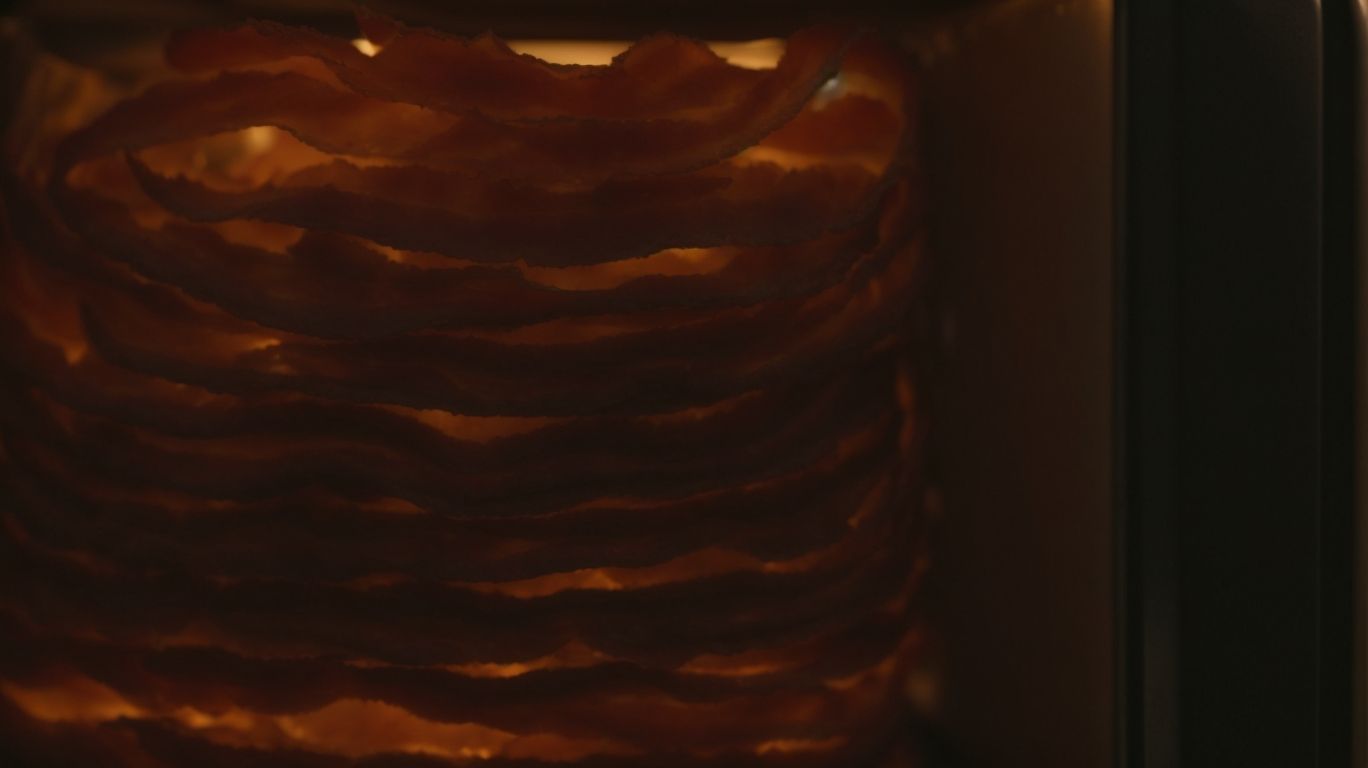
Credits: Poormet.Com – Jack Adams
Before cooking bacon in the microwave, it is essential to consider the type of bacon, microwave, and microwave-safe dish to ensure optimal cooking results.
Regarding selecting the type of bacon, consider factors like thickness and fat content. Thicker bacon may require longer cooking times, while leaner bacon cooks faster. For microwave options, ensure you choose a microwave with adequate wattage for efficient cooking, usually around 800-1200 watts. Opt for a microwave-safe dish that fits the bacon strips comfortably without overcrowding to allow for even cooking. Always check that the dish is labeled as microwave-safe to prevent any mishaps during the cooking process.
Type of Bacon
The type of bacon chosen, whether it be thick-cut slices or regular bacon, can impact the final texture of the crispy bacon cooked in the microwave.
When selecting the optimal bacon for microwave cooking, considering the thickness of the bacon slices is crucial. Thicker bacon tends to result in a more robust and chewy texture, offering a hearty bite and rich flavor profile. On the other hand, thinner bacon slices tend to crisp up faster and can provide a delicate crunch with each bite. The cut of the bacon, whether it’s from the belly or the back, can also affect the overall taste and texture. Choosing the right bacon that aligns with your desired level of crispiness can elevate your microwave-cooked bacon experience.
Type of Microwave
The power level and settings of the microwave should be adjusted according to the specific instructions provided to ensure proper cooking of the bacon.
When cooking bacon in the microwave, understanding how different power levels affect the cooking process is crucial. Lower power settings can help prevent overcooking or burning while higher settings can expedite the cooking process. Following the recommended heating guidelines, such as using a microwave-safe dish covered with a paper towel or microwave-safe lid, can help retain moisture and flavor in the bacon slices.
It is also essential to consider the thickness of the bacon slices when adjusting the power level – thicker slices may require a lower power setting and longer cooking time, whereas thinner slices can be cooked more quickly at a slightly higher power level.
Type of Microwave-safe Dish
Using a suitable microwave-safe plate or dish to layer the bacon slices ensures even cooking and prevents potential damage to the cooking vessel.
When selecting a microwave-safe plate or dish for your bacon, it’s crucial to consider the material. Opt for dishes labelled as microwave-safe to avoid any risks during the cooking process, ensuring your dish can withstand the microwave’s heat levels. A dish with a larger surface area allows more even distribution of heat, resulting in uniformly cooked bacon strips.
Proper layering techniques also play a significant role in microwave bacon preparation. Arrange the bacon slices in a single layer, ensuring they do not overlap to promote consistent cooking. It’s best to leave a small gap between each slice to prevent them from sticking together during cooking.
Step-by-Step Guide to Cooking Bacon on Microwave
Follow this step-by-step guide to cooking bacon in the microwave for perfectly crispy and delicious results every time.
Begin by laying out your bacon strips on a microwave-safe plate, ensuring they do not overlap to ensure even cooking.
- Cover the bacon strips with a paper towel to prevent splattering and place another microwave-safe plate on top to cover.
- Microwave the bacon on high power for 4-6 minutes, rotating the plate halfway through the cooking process to ensure uniform crispness.
- Check for doneness by looking for a golden-brown color and a slightly crispy texture.
Preparing the Bacon
The first step in cooking bacon in the microwave is preparing the bacon slices according to the specific instructions provided, ensuring they are arranged appropriately on a microwave-safe dish.
Before you begin, make sure the bacon slices are thawed if they were frozen, as cooking frozen bacon can lead to uneven cooking. Next, take a microwave-safe dish with edges to prevent any grease splatters. It’s crucial to lay the bacon slices flat on the dish, ensuring they do not overlap to ensure even and consistent cooking. A great tip is to place a paper towel underneath the bacon to absorb excess grease during cooking, resulting in crispy bacon strips.
Arranging the Bacon on a Microwave-safe Dish
Properly layer the bacon on a microwave-safe plate or tray to ensure even cooking and minimize splattering during the microwave process.
When arranging the bacon, ensure that the slices do not overlap, as this can lead to uneven cooking and parts of the bacon remaining raw. By layering the bacon slices next to each other instead of on top of one another, you allow the heat to circulate evenly, resulting in a perfectly cooked batch. Choose a microwave-safe plate or tray that is large enough to accommodate the bacon without crowding. This reduces the chance of grease splattering in the microwave, making cleanup a breeze.
Cooking Time and Power Level
Set the appropriate cooking time and power level on the microwave based on the bacon thickness and desired crispiness to achieve optimal results.
When cooking bacon, the thickness of the slices plays a significant role in determining the ideal cooking time. Thicker cuts require longer cooking durations to ensure they are thoroughly cooked and reach the desired level of crispiness. Conversely, thinner slices may cook faster. Adjusting the microwave power level can also influence the cooking process, allowing you to control the intensity of heat applied to the bacon. Experimenting with different power settings can help you find the right balance between cooking efficiently and achieving the perfect texture.
Checking and Flipping the Bacon
Periodically check and flip the bacon slices during the microwave cooking process as per the provided directions to ensure uniform and thorough cooking.
When cooking bacon in the microwave, it’s crucial to keep an eye on the slices to prevent them from overcooking or undercooking. By monitoring the progress, you can adjust the cooking time accordingly to achieve that perfect balance of crispiness. Flipping the bacon slices halfway through the cooking time promotes even browning on both sides, resulting in a satisfyingly cooked batch. Pay attention to the sizzling sound and visual cues of the bacon to gauge when it’s time to flip, ensuring each piece is cooked to perfection.
Drain and Serve
After cooking, drain excess grease and serve the crispy bacon slices hot for a delicious and satisfying dish that is ready to enjoy.
Once the bacon is cooked to perfection, carefully tilt the pan to allow any excess grease to collect on one side.
Using a pair of tongs, transfer the crispy bacon slices onto a plate lined with paper towels to absorb any remaining grease.
For a visually appealing presentation, place the bacon slices neatly on a serving platter, garnishing them with a sprinkle of freshly ground black pepper or a drizzle of maple syrup for a touch of sweetness.
Pair this savory bacon dish with some fluffy scrambled eggs, toasted whole grain bread, and a side of vibrant avocado slices for a well-rounded and satisfying breakfast feast.
Tips for Perfectly Cooked Bacon on Microwave
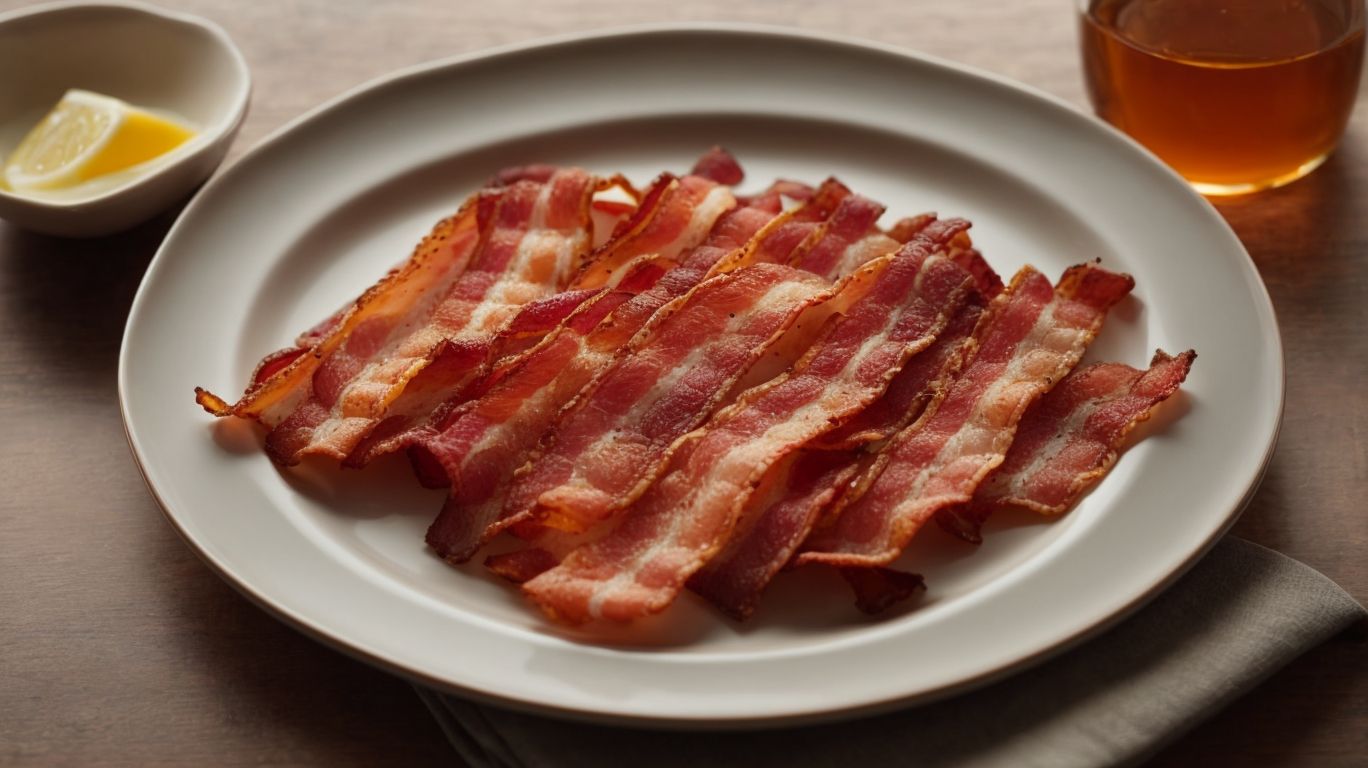
Credits: Poormet.Com – Elijah Gonzalez
Enhance your microwave bacon cooking skills with these expert tips to achieve perfectly cooked and delicious results every time.
To ensure your bacon turns out crispy and delicious, start by laying out a few layers of paper towels on a microwave-safe plate before placing the bacon strips on top. The paper towels will help absorb excess grease during cooking, resulting in a crunchier texture. Alternatively, using a specialized bacon tray or rack can elevate your cooking game, allowing the bacon to cook evenly and preventing it from sitting in its own grease. Remember, the cooking time may vary depending on the thickness of the bacon slices, so adjust accordingly to ensure that each piece is perfectly cooked.
Cover the Bacon with Paper Towels
Before cooking, cover the bacon slices with paper towels to absorb excess grease and prevent splattering, resulting in cleaner and more controlled cooking outcomes.
When preparing bacon for microwave cooking, the paper towels act as a barrier between the bacon and the microwave plate, absorbing the excess grease that would otherwise make a mess. This not only helps in maintaining a cleaner cooking environment but also prevents any splattering, which can be a common issue when cooking bacon.
To use this technique effectively, simply place a few layers of paper towels on top of the bacon slices before heating them in the microwave. The paper towels will soak up the released grease during the cooking process, reducing the risk of any oil-related accidents and making clean-up much easier afterwards.
Use a Bacon Tray or Rack
Opt for a specialized bacon tray or rack to elevate the bacon slices during cooking, allowing proper airflow and enhanced crispiness for a delightful bacon experience.
Using a dedicated bacon tray or rack offers numerous advantages when it comes to microwave cooking. These specialized tools promote improved airflow around the bacon, ensuring that each slice cooks evenly and crisps up perfectly. By elevating the bacon off the surface of the microwave-safe dish, the tray or rack helps to prevent soggy or greasy results often associated with microwaved bacon. The enhanced airflow also aids in achieving that desired crispy texture, making your bacon not only tasty but also visually appealing.
Adjust Cooking Time for Thicker Cuts of Bacon
When cooking thicker cuts of bacon in the microwave, be sure to adjust the cooking time accordingly based on the provided instructions to achieve the desired level of crispiness.
Thicker bacon slices require a slightly longer cooking duration than their thinner counterparts due to their density and moisture content. To ensure even cooking, consider using a microwave-safe bacon tray or a plate lined with paper towels to absorb excess grease and prevent splattering. For every half-inch increase in thickness, add an additional 30 seconds to the recommended cooking time. Checking the bacon periodically is crucial to prevent overcooking and maintain its flavor and texture.
Common Mistakes to Avoid when Cooking Bacon on Microwave
Learn about the common mistakes to avoid when cooking bacon in the microwave to ensure a smooth and successful bacon preparation experience.
One prevalent error that many people encounter when cooking bacon in the microwave is overcooking, which can result in dry, tough bacon strips. To prevent this, it is essential to monitor the cooking time carefully, as bacon can quickly go from perfectly crisp to burnt if left unattended.
Another common mistake is selecting the wrong dish for microwaving bacon. Using a dish that is too small can lead to overcrowding and uneven cooking, while a plate that is too large may not contain the grease effectively, causing splatters and a messy microwave.
Ensuring proper grease drainage is also crucial. Placing a paper towel underneath the bacon strips can help absorb excess grease and prevent the bacon from becoming soggy during cooking.
Overcooking the Bacon
Avoid overcooking the bacon in the microwave by following the recommended instructions and cooking times to preserve the bacon’s texture and flavor.
Overcooking bacon in the microwave can result in dry, tough, and unappetizing strips that lack the delicious juiciness and savory crunch we all love. To prevent this culinary disaster, it’s crucial to adhere to the specified cooking durations and power levels, ensuring that your bacon is cooked just right.
- When cooking bacon in the microwave, always cover it with a paper towel to prevent splattering and maintain moisture.
- Splitting the cooking time into shorter intervals and checking the progress can help you achieve optimum results without risking overcooking.
By managing your time effectively and monitoring the process, you can savor perfectly cooked bacon every time, packed with flavor and satisfaction.”
Not Using a Microwave-safe Dish
Ensure proper cooking by always using a microwave-safe dish for bacon preparation, as unsuitable containers may lead to safety hazards and cooking inefficiencies.
Regarding cooking bacon in the microwave, the choice of dish plays a crucial role in the outcome. Using dishes not intended for microwave use can result in them becoming too hot, potentially causing burns or even fires. Microwave-safe dishes are designed to withstand the specific heat levels generated in microwaving, ensuring a safe cooking process.
It is recommended to opt for dishes that are labeled as microwave-safe. Glass, ceramic, and certain types of plastics are usually suitable choices. Always check the manufacturer’s instructions to verify if a dish is microwave-safe before using it for bacon preparation.
Not Draining the Bacon Properly
Properly draining excess grease from the cooked bacon is crucial to achieving a desirable texture and taste, ensuring a satisfying dish presentation and enjoyable eating experience.
One effective method for draining excess grease from microwave-cooked bacon is to lay the strips on a plate lined with paper towels. The paper towels will absorb the excess grease, helping to reduce the overall greasiness of the bacon. It’s important to pat the bacon gently with another layer of paper towels to ensure maximum grease removal. For a cleaner process, you can also use a wire rack placed over a baking sheet to allow the grease to drip down.
Conclusion
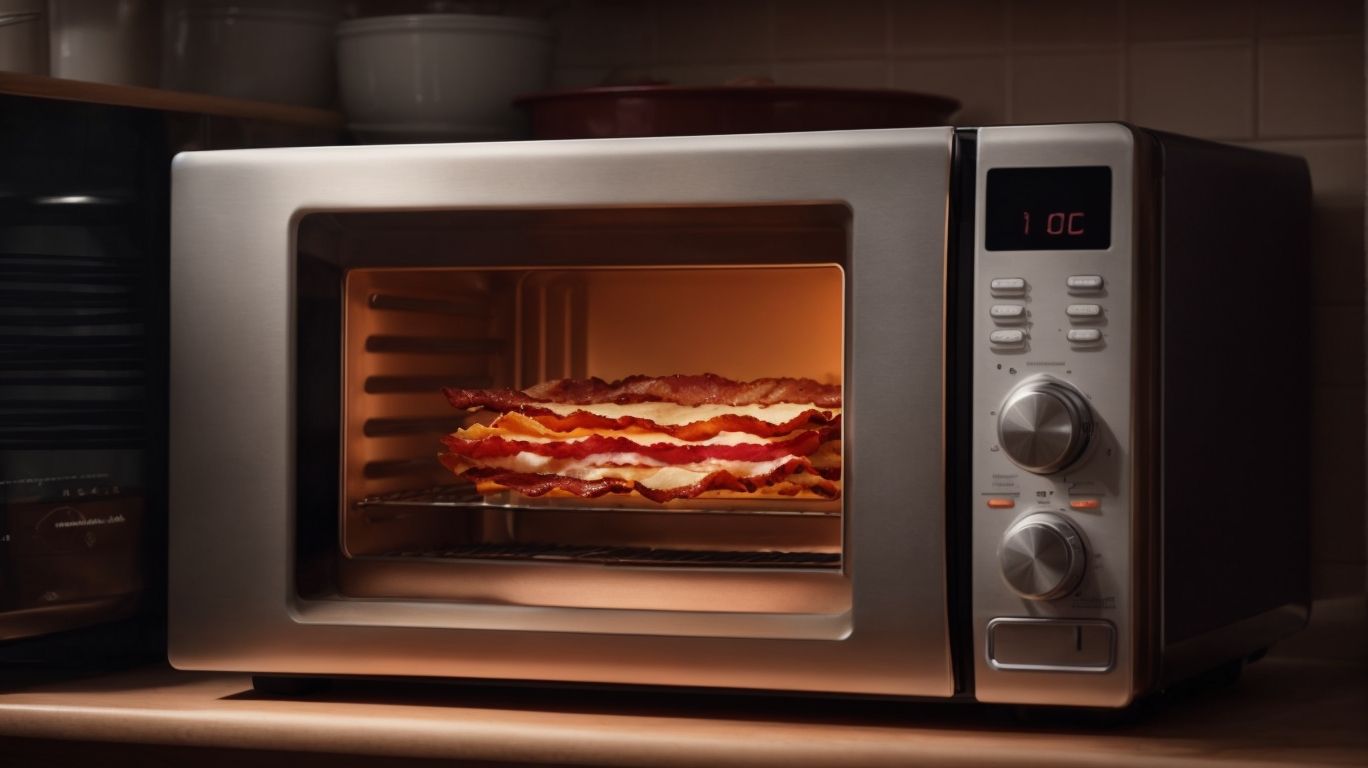
Credits: Poormet.Com – Roy Hernandez
Cooking bacon in the microwave is a practical and efficient method to achieve crispy and delicious bacon slices with minimal effort and maximum flavor.
By using the microwave, you can save time and avoid the mess associated with traditional stovetop methods, making it an ideal choice for busy mornings or quick meal preparations. The convenience of microwaving bacon allows you to enjoy a tasty breakfast treat in just a few minutes, perfect for those rushed mornings before work or school. The consistent results from microwave cooking ensure that every bite of your bacon will be perfectly cooked to your liking, whether you prefer it crispy or slightly chewy. Plus, the ease of preparation means you can spend less time in the kitchen and more time enjoying your delicious meal.
Frequently Asked Questions
How to Cook Bacon on Microwave?
To cook bacon on the microwave, simply place the bacon strips on a microwave-safe plate lined with paper towels. Cook for 1-2 minutes for every slice of bacon, depending on the thickness. Flip the bacon halfway through and continue cooking until crispy.
Can you cook bacon on the microwave without paper towels?
Yes, you can cook bacon on the microwave without paper towels, but it may result in a messier clean-up. Instead, place the bacon strips on a microwave-safe plate and cover with a microwave-safe lid or plastic wrap to prevent splattering.
How do you prevent bacon from splattering in the microwave?
To prevent bacon from splattering in the microwave, cover the bacon with a microwave-safe lid or plastic wrap. This will trap the heat and moisture, preventing it from splattering all over the microwave.
Can you microwave bacon from frozen?
Yes, you can microwave bacon from frozen. Place the frozen bacon strips on a microwave-safe plate and cook for 1-2 minutes for every slice, flipping halfway through. Keep in mind that it may take longer to cook compared to thawed bacon.
Is it safe to cook bacon on the microwave?
Yes, it is safe to cook bacon on the microwave as long as you follow proper cooking guidelines and precautions. Use a microwave-safe plate and cover the bacon to prevent splattering. Also, be careful when handling hot bacon and always use oven mitts.
Can you save bacon grease from cooking in the microwave?
Yes, you can save bacon grease from cooking in the microwave. Simply pour the grease into a heat-proof container and let it cool before storing it in the fridge. You can use the bacon grease for cooking or flavoring dishes.


